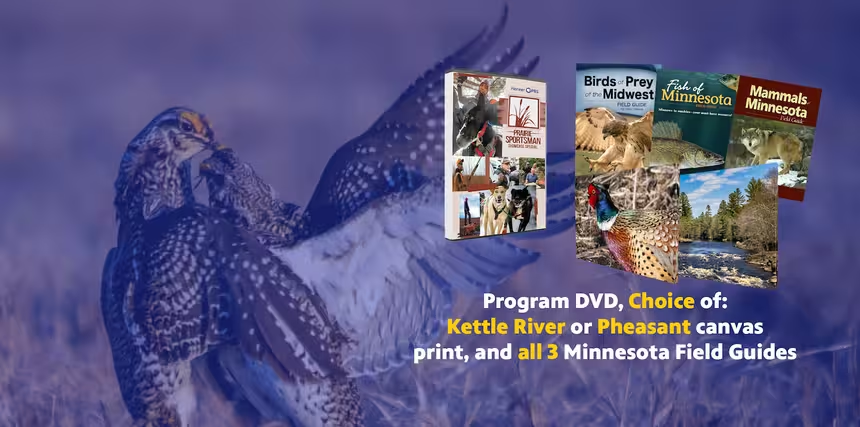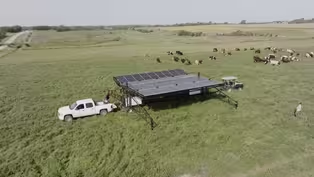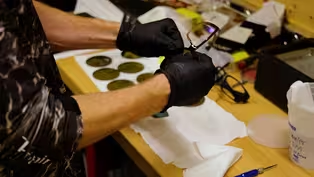Prairie Sportsman
Protecting Minnesota Waters from Invaders
Clip: Season 16 Episode 11 | 6m 12sVideo has Closed Captions
Minnesota lottery dollars help stop the spread of aquatic invasive species.
The Minnesota Environment and Natural Resource Fund has awarded more than a billion dollars to environmental projects, including efforts to stop the spread of invasive species. Minnesota research centers and the DNR are developing strategies such as using genetic controls to eradicate zebra mussels and tagging silver and bighead carp, leading to large captures of the invasive fish.
Problems playing video? | Closed Captioning Feedback
Problems playing video? | Closed Captioning Feedback
Prairie Sportsman is a local public television program presented by Pioneer PBS
Production sponsorship is provided by funding from the Environment and Natural Resources Trust Fund, West Central Initiative, Shalom Hill Farm, and members of Pioneer PBS.
Prairie Sportsman
Protecting Minnesota Waters from Invaders
Clip: Season 16 Episode 11 | 6m 12sVideo has Closed Captions
The Minnesota Environment and Natural Resource Fund has awarded more than a billion dollars to environmental projects, including efforts to stop the spread of invasive species. Minnesota research centers and the DNR are developing strategies such as using genetic controls to eradicate zebra mussels and tagging silver and bighead carp, leading to large captures of the invasive fish.
Problems playing video? | Closed Captioning Feedback
How to Watch Prairie Sportsman
Prairie Sportsman is available to stream on pbs.org and the free PBS App, available on iPhone, Apple TV, Android TV, Android smartphones, Amazon Fire TV, Amazon Fire Tablet, Roku, Samsung Smart TV, and Vizio.

Prairie Sportsman Premium Gifts
Do you love the great outdoors, hunting, fishing, hiking and conservation? Consider becoming a friend of Prairie Sportsman to support it and receive gifts with your contribution.Providing Support for PBS.org
Learn Moreabout PBS online sponsorship(gentle music) - [Bret] "Prairie Sportsman" celebrates our love of the outdoors and opportunities to hunt, fish, and recreate, provided by our vast resources of lakes, streams, forests, and grasslands To protect these natural assets, the State of Minnesota directs 40% of the state's lottery proceeds to the Environment and Natural Resources Trust Fund.
A 1988 Minnesota constitutional amendment created the trust fund that was set to expire in 2025.
But, last year, Minnesota voters renewed the fund for another quarter century, guaranteeing a long-term, stable source of funding for environmental protections, including efforts to stop the spread of aquatic invasive species.
(gentle music) (light airy music) Every year, about 5% of trust fund dollars are awarded to environmental projects recommended by the Legislative Citizen Commission on Minnesota Resources.
One of LCCMR's major funding priorities is aquatic invasive species research.
Much of this work has been featured on "Prairie Sportsman," including projects at the Minnesota Aquatic Invasive Species Research Center - We've got dozens of species we're worried about here in Minnesota right now, and there are tenfold more on our doorstep that we're worried about coming in.
The value of having a center-based approach for a problem like this is it's just so incredibly complex and large scale.
We bring together disciplines from across the university and stakeholders across the state, country, and around the world to help solve these problems.
(gentle music) - [Bret] Zebra mussels and spiny waterfleas are two of the invaders wreaking havoc with anglers.
- One study looked at how zebra mussels and spiny waterflea were affecting yellow perch and walleye in what we know as Minnesota's nine large walleye lakes.
What they found was that in lakes that had zebra mussels and spiny waterflea, walleye growth was 25% smaller going into their first winter.
- [Bret] The AIS Research Center has developed protocols and nets that volunteers can use to detect the invasive species' presence.
Identifying where the spiny invaders are present can alert boaters to be extra cautious when leaving these lakes.
- Stopping the spread is actually pretty easy.
It's just a matter of following that clean, drain, dry mantra.
And with spiny waterflea, dry is the really key element, because they do desiccate and die quickly.
And so we tell people, "You wanna, like, leave your fishing gear out in the sun," and then wiping down the fishing pole eyelets is really important.
- [Bret] To control zebra mussels, researchers have seen some positive results using low levels of copper pesticides.
But even more promising are genetic control strategies.
- We're testing genetic control strategies to see if we can turn genes on or off.
And if we can do that, then we can get them to do whatever we want.
- [Bret] The Center's also designing genetic control strategies for common carp that stir up sediment and impact water quality.
But the more dangerous species are bighead and silver carp that are moving up the Mississippi and knocking on Minnesota's southern door.
- [Kayla] Of the three invasive carp that we have in Minnesota, bighead carp tend to get the biggest, silver carp are the ones that jump.
- [Bret] The DNR has employed seining crews to capture and tag invasive carp to track their movement.
- The biggest problem with invasive carp is that where they land in the food chain, they eat algae, they eat, you know, phytoplankton and zooplankton.
So they're eating what everything else needs at some point in their life to survive.
- [Bret] Agencies use several different methods to remove carp.
- [Kayla] Netting is probably the the best way.
And that's what's been proven down south in high-density populations is that commercial fishing tends to be the easiest way to remove these fish.
- [Bret] Environment and Natural Resources Trust Fund efforts to protect our waters are also being carried out at the St. Croix Watershed Research Station.
Scientists are investigating why invasive species are showing up in places they've never been seen before.
Toxic blue-green algae blooms are typically found in waters polluted with nutrient runoff, but they have been discovered in Isle Royale National Park and rock snot is showing up in Northeast Minnesota streams.
- Didymo has lived fairly happily on the shore of Lake Superior and people don't notice it too much.
This is the first time we've seen it in streams in Minnesota.
We don't understand how the north shore is gonna respond to it and our north shore streams are gonna respond to it.
That's what we're working on, spending our our research effort to understand this brand-new phenomenon.
- [Bret] The Environment and Natural Resources Trust Fund has awarded more than a billion dollars to projects that protect, conserve, and enhance Minnesota's natural resources, and our quality of life in the outdoors will be enriched for years to come.
(gentle music) - [Lisa] Stories about aquatic invasive species research are brought to you by the Aquatic Invasive Species Task Forces of Meeker, Yellow Medicine, Lac qui Parle, Swift, and Big Stone Counties, and by the Environment and Natural Resources Trust Fund.
We can stop aquatic hitchhikers from infesting more lakes and streams by cleaning up everything we pull out of the water.
It's a simple drill, clean in, clean out.
Before leaving a water access, clean your boat and water equipment; remove and dispose of all plants and aquatic species in the trash drain water from your boat, ballast tanks, motor, livewell, and bait container; remove drain plugs and keep drain plugs out while transporting equipment; dispose of unwanted bait in the trash.
To keep live bait, drain the water and refill the bait container with bottled or tap water.
And if you have been in infested waters, also spray your boat with high-pressure water, rinse with very hot water, dry for at least five days.
Stop the spread of a IAS.
Camouflage Face Paints and Mobile Solar
Preview: S16 Ep11 | 30s | Host Bret Amundson visits RLVNT, learn about mobile solar panels, and aquatic invasive species. (30s)
Video has Closed Captions
Clip: S16 Ep11 | 5m 10s | Western Minnesota researchers develop mobile solar panels for cow pastures. (5m 10s)
Video has Closed Captions
Clip: S16 Ep11 | 14m 16s | Bret visits RLVNT to learn about how they solve for real life vexes with new technology. (14m 16s)
Providing Support for PBS.org
Learn Moreabout PBS online sponsorship
- Science and Nature

Explore scientific discoveries on television's most acclaimed science documentary series.

- Science and Nature

Capturing the splendor of the natural world, from the African plains to the Antarctic ice.












Support for PBS provided by:
Prairie Sportsman is a local public television program presented by Pioneer PBS
Production sponsorship is provided by funding from the Environment and Natural Resources Trust Fund, West Central Initiative, Shalom Hill Farm, and members of Pioneer PBS.




